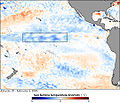La Niña
![]()
This article or section is still missing the following important information:
A more precise, clear description of the mechanism is missing, esp. in comparison to El Nino. I have added something to it, but this is probably the absolute minimum. The article should be expanded to bring it up to a comparable level to the El Nino article. -- Mons Maenalus (discussion) 01:30, 21 Nov 2017 (CET)
Help Wikipedia by researching and adding them.
La Niña (Spanish for 'the girl') is a weather event that usually occurs following an El Niño event. It is its counterpart, so to speak. La Niña is accompanied by above-average differences in air pressure between South America and Indonesia (see Southern Oscillation). This leads to stronger trade winds and a generally strengthened but cooled Walker circulation. Warm surface waters from the Pacific Ocean are increasingly driven to Southeast Asia by the trade winds. As a result, more cold water flows in from the deep off the coast of Peru, which is up to 3 °C below the average temperature.
The generally strengthened but now cooled atmospheric circulation is the cause of teleconnections affecting the Atlantic, as these air masses reach the Atlantic due to westward wind drift in temperate latitudes.
The impacts are not as strong as El Niño, but La Niña still has a significant impact:
- In the western Pacific, the water is warmer at the surface. As a result, the more the temperatures in the eastern part of the Pacific Ocean differ from those in the western areas, the more rain falls on Australia's northeast coast.
- In Southeast Asia, La Niña brings heavy rain that can trigger landslides. In the second half of 2010, it rained there more than at any time since weather records began. The record rainfall at the end of 2010 led to flooding in the northeastern Australian state of Queensland and in northern New South Wales, the extent of which was roughly equivalent to half the area of the German state of Bavaria - while extreme drought, the likes of which had never been seen before, prevailed in southwestern Australia.
- In South America, on the other hand, it rains less and the deserts dry out.
- In North America, the occurrence of hurricanes is favored.
However, in the direct influence area - if teleconnections are disregarded - fewer natural disasters occur than during an El Niño.
· 
Sea surface temperature from January to February 2006 clearly shows the cooling in the equatorial Pacific that is characteristic of La Niña ...
· 
... as well as here in November 2007 ...
· 
... and as last seen in April 2008, where additionally a Pacific Decadal Oscillation (PDO) anomaly can be seen west of the North American coast.
It is striking that the number of La Niña events decreased and El Niño events increased between 1970 and about 1995. Therefore, the assumption arose that the anthropogenic greenhouse effect was responsible for this, but this could not be proven, especially since the trend has clearly reversed since the end of the 1990s and the long-term average value of the 20th century has been reached again (source: SOI archives of the Australian Bureau of Meteorology). Currently, it is believed that these fluctuations are largely due to natural variations, as warm and cold phases, called the Pacific Decadal Oscillation (PDO) with its two phases El Viejo and La Vieja, alternate in the Pacific Ocean at intervals of about 20-30 years. The short-term influence of climate warming on such climate distribution systems has probably been overestimated so far, but this may change in a few years, as these systems have a certain inertia to changes in individual factors.

Graphic representation for La Niña
See also
- El Niño-Southern Oscillation
- Southern Oscillation Index
Search within the encyclopedia